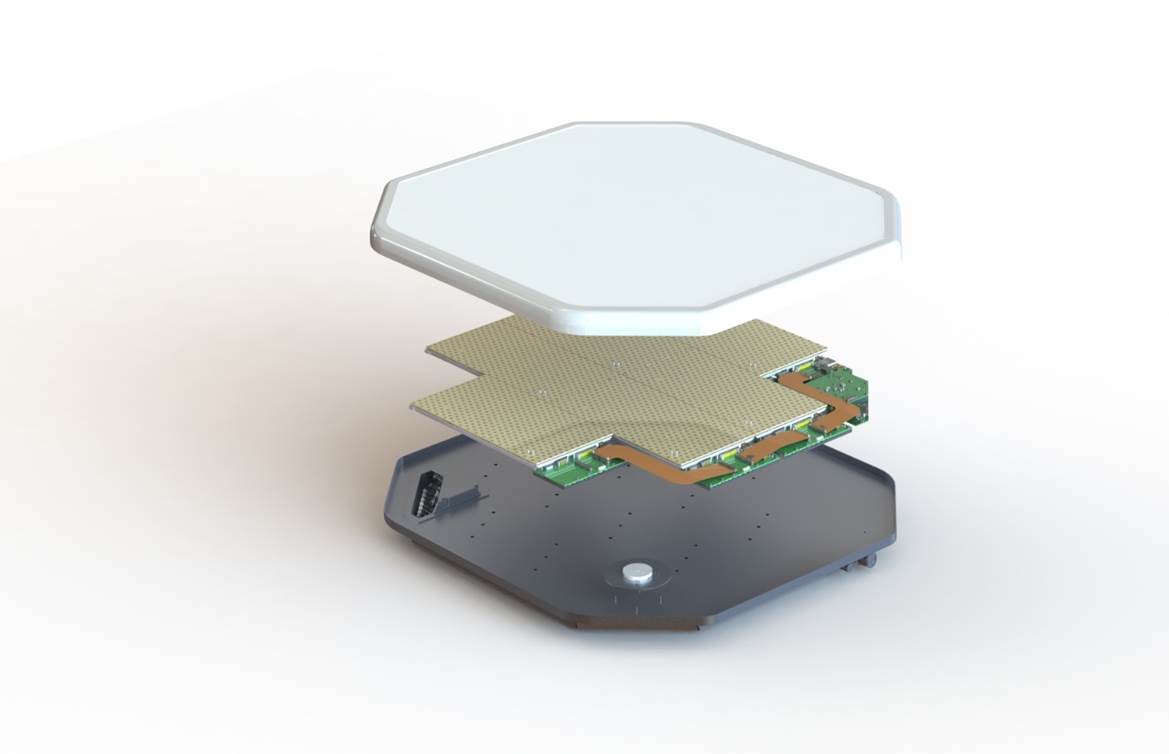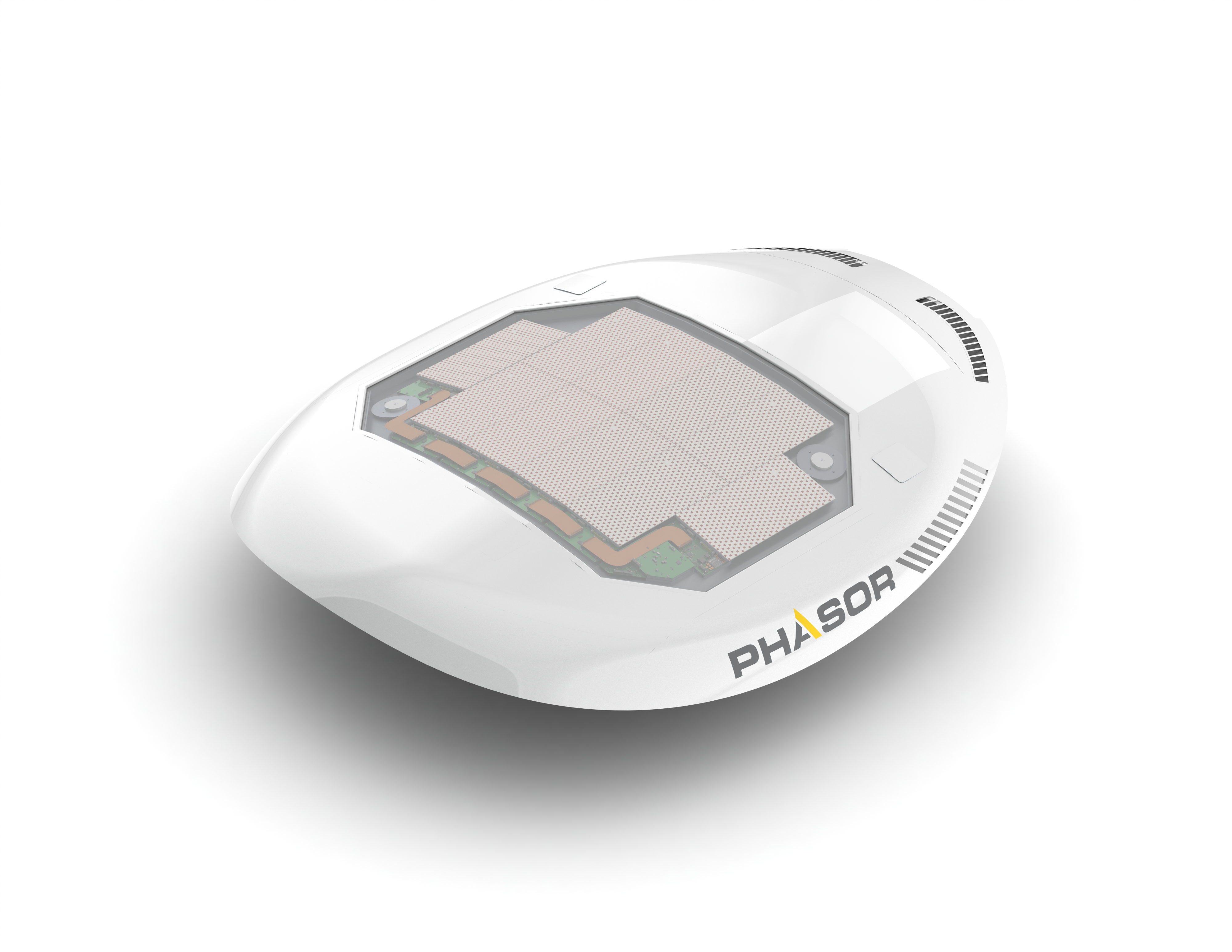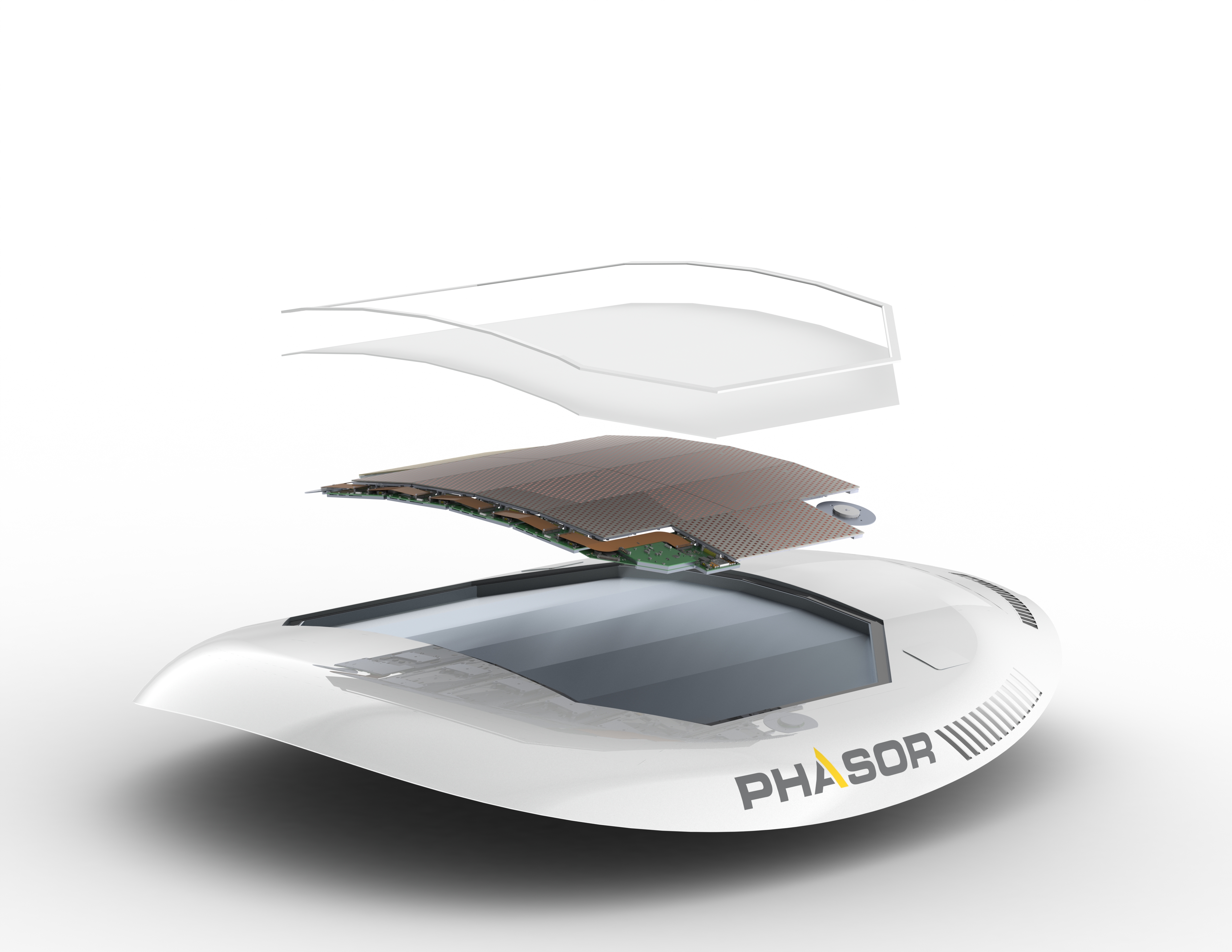An ear to the ground for next-gen satellite connectivity
Vicor’s Factorised Power Architecture (FPA) is helping Hanwha Phasor revolutionise satellite broadband connectivity to deliver extremely high current at low voltage for uninterrupted mobile communications
Anyone who has tried to access the internet in a moving vehicle knows the frustrations of signals dropping at the most inconvenient moment. Users demand connectivity speeds and bandwidth enabling them to browse and send messages; stream music and video; and hold multi-connection video conference meetings without interruption on any mode of transport.
Based on advanced dynamic beam-forming technologies and system architecture, Hanwha Phasor’s scalable, low profile, high gain active electronically steered antenna (AESA) addresses the requirement for enterprise communications-on-the-move today, and low earth orbit (LEO) and medium earth orbit (MEO) constellations tomorrow.
Figure 1: The Phasor steerable one step antenna
Antenna technology
A Hanwha Phasor antenna is based on a modular architecture. Its core antenna module comprises several PCB assemblies. The upper PCB hosts the antenna board comprising an array of patch antennae on the front and Hanwha Phasor’s application specific integrated circuit (ASIC) on the back. The board is powered by a custom voltage converter, leveraging modules from Vicor’s Factorised Power Architecture (FPA).
This almost flat, solid-state, electronically steered antenna system can be embedded into the roofs of vehicles, eliminating the need for bulky mechanically operated satellite dishes requiring regular maintenance. Less than 25mm thick, the Hanwha Phasor unit can match the performance of a dish that is 2.4m wide or larger depending on aperture size and is inherently more reliable. The antenna system is conformable, allowing it to fit the shape of most vehicles. It is also scalable through its modular architecture.
Hanwha Phasor’s system, with its high power density and low profile components, must deliver extremely high current at a very low voltage. FPA was selected as a power system because it is ahead of the market in terms of size, density and ability to deliver modular, scalable high performance, says Vicor.
Factoring in functionality
Advanced processors need higher currents when their load voltages drop below one volt. Density and low noise at point of load are becoming even more critical to processor performance. The continuing challenge for system designers is to accommodate lower voltages with faster transient response and better power system efficiency in an ever shrinking board area.
FPA solves these problems, taking the DC/DC converter functions of regulation and conversion and factorising it into its two constituent parts. This allows for complete optimisation of each function, resulting in a high efficiency regulator, coupled with a high density current delivery device for various low voltage high current loads. FPA consists of a pre-regulator module (PRM) and a voltage transformation module (VTM) / current multiplier. These two devices work together, each fulfilling a specialised role efficiently to provide a complete DC/DC conversion function.
The PRM supplies a regulated output voltage, or ‘factorised bus’ from an unregulated input source. This bus feeds one or more VTMs which transform the factorised bus voltage to the level needed by their loads, while providing isolation. This enables a PRM VTM chipset to provide the full, regulated, isolated DC/DC converter function.
Factorised power means more space at points of load, improving system efficiency by dissipating less power and enabling the regulation function to be remotely located.
Figure 2: The layers used in the Phasor steerable antenna
Components for FPA
The PRM uses a patented zero voltage switching (ZVS) buck-boost regulator control architecture to give high-efficiency, step-up and step-down voltage regulation and a soft start. Maximum efficiency is achieved when VIN = VOUT. The latest PRMs achieve 99.3% peak.
The VTM current multiplier is a high-efficiency voltage transformation module (VTM) using a proprietary zero current switching / zero voltage switching (ZCS/ZVS) Sine Amplitude Converter (SAC). It operates on a pure sinusoidal waveform with high spectral purity and common mode symmetry. These characteristics mean that it does not generate the harmonic content that typical PWM type converters exhibit and it produces virtually minimal noise. The control architecture locks the operating frequency to the powertrain resonant frequency, allowing up to 97% efficiency and minimising output impedance by effectively cancelling reactive components. This very low, non-inductive output impedance allows it to respond almost instantaneously to step changes in the load current.
The VTM responds to load changes regardless of magnitude in less than one microsecond with an effective switching frequency of 3.5MHz. The VTM's high bandwidth obviates the need for large point of load (PoL) capacitance. Even without any external output capacitors, the output of a VTM exhibits a limited voltage perturbation in response to a sudden power surge. A minimal amount of external bypass capacitance (in the form of low equivalent series resistance / equivalent series inductances (ESR / ESL) ceramic capacitors) is enough to eliminate any transient voltage overshoot.
Transformation
An essential factor in the operational success of Hanwha Phasor’s antenna is the ability of Vicor’s systems to transform a 48V into a 1.5V supply (even lower in the next generation of antenna). This requirement for a flexible power module than can provide up to 80A depending on system requirements, represented a major design challenge to the team.
Hanwha Phasor looked at a range of solutions. Some were not able to address heat dissipation. With a height of 25mm, there is no room in the antenna panel for a cooling fan, so conduction cooling was needed to generate (and waste) as little heat as possible.
Secondly, traditional methods of transforming voltage would involve multi-phase hard switching converters to attain the required load currents, consuming considerably more PCB real estate and creating significant amounts of EMI. The VTM, because it is a resonant converter, has very low noise when compared to a hard switched converter. At the same time, the Vicor solution was superior to traditional DC/DC converters in terms of power delivery and efficiency.

Figure 3: The Phasor M6 antenna electronically steered antenna (ESA) for defence applications
Lower voltages, higher currents
Vicor and Hanwha Phasor’s work represents a breakthrough in what is expected to become a multi-million dollar market for enterprise communications on the move. The antenna meets the requirements of a variety of enterprise applications from commercial maritime and overland trains to aircraft – business and large jets – and government organisations wanting rapidly deployable systems for covert operations. Market development will be substantively spurred by the launch of the LEO satellite systems which deliver ubiquitous broadband speed wherever it is needed.
For the two companies, the next challenge is the move to lower voltages (1V or less) with even higher currents.
The four-year strategic supplier relationship enables the experts in flat AESAs to keep the modular power specialist up to-date with the power requirements of its latest ASICs. In turn, Vicor will keep Hanwha Phasor updated with the latest in factorised power.
Continued collaboration
Under new ownership, Hanwha Phasor is forging ahead with its active 100% electronically steered array. It is the only demonstrated low profile, low maintenance, high gain antenna system for communications on the move, future-proofed for LEO/MEO satellites.
Headquartered in London, Hanwha Phasor Ltd was set up in June 2020 to acquire the technology pioneered by Phasor Solutions, a UK start-up. Hanwha Phasor is a subsidiary of Hanwha Systems, part of the $63 USD billion Korean-based group with wide interests including aerospace, defence and green energy.
Substantial investment is now in place with a clear road map to industrialise Hanwha Phasor’s technology.
Engineers will highlight the latest stage of technology readiness at Satellite 2021, Washington DC, USA (July) and Modern Day Marine, Marine Corps Base Quantico, VA, (September 2021).
https://www.hanwha-phasor.com/
About the author:
Andy Maughan is director of business development EMEA, Vicor UK. The Physics and Electronics graduate has worked as a design engineer/project manager, leading teams of multidisciplinary engineers in the development of numerous domestic, high volume, electronic electricity meters. Today, he is responsible for working with both assigned customers and Vicor’s channel partners to develop the business by understanding repeatable market trends.













